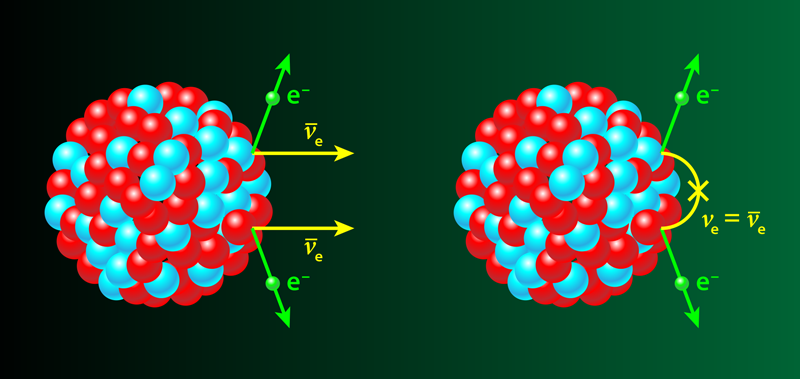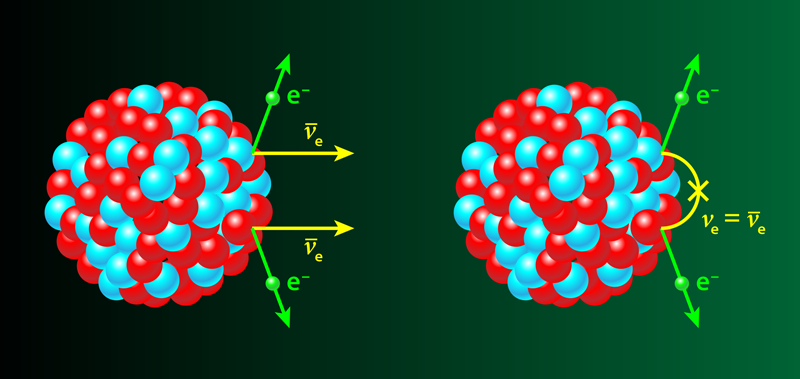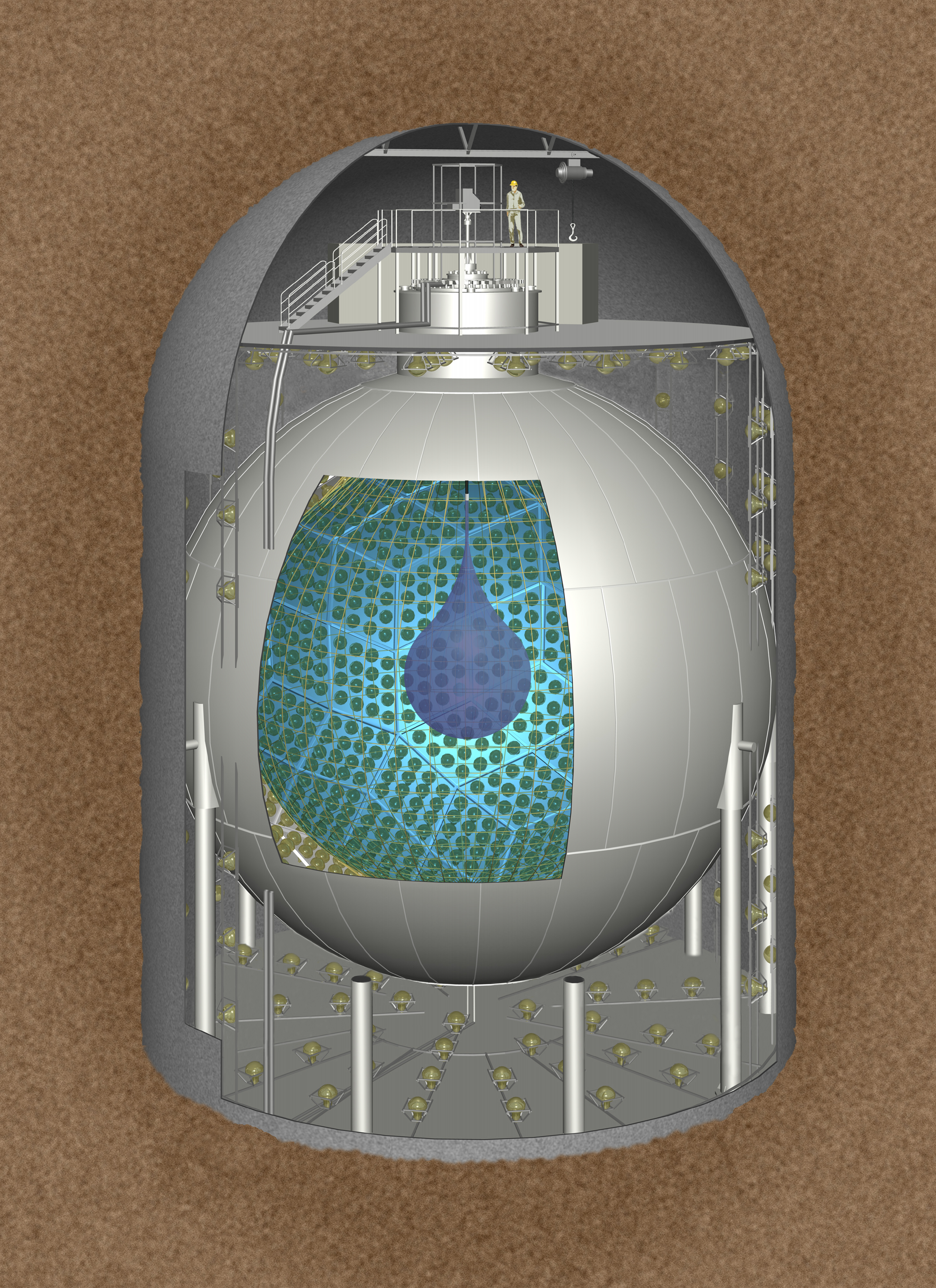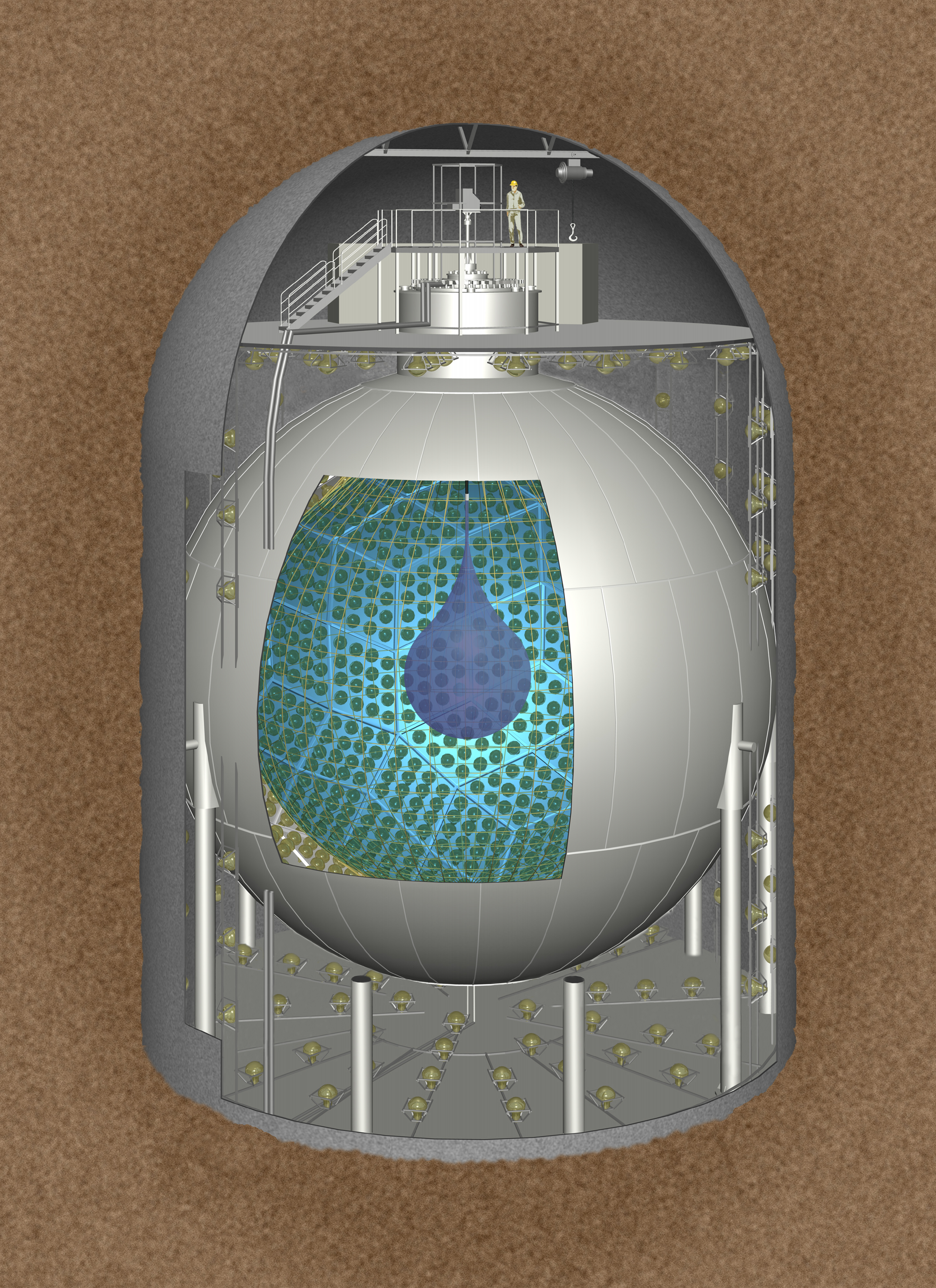Probing Majorana Neutrinos
Despite being among the most abundant particles in the Universe, neutrinos are extremely difficult to detect. Almost 100 years after they were predicted, and almost 70 years after their detection, several of the particles’ properties remain unknown, most notably their mass and their “nature”—whether they are their own antiparticles. An exceedingly rare nuclear decay without the emission of neutrinos, called neutrinoless double-beta ( 0𝜈𝛽𝛽) decay, could shed light on these questions (see Viewpoint: The Hunt for No Neutrinos), but so far this hypothetical process has not been observed. Now, the KamLAND-Zen Collaboration has reported an improved search for 0𝜈𝛽𝛽 decay in a xenon-loaded liquid scintillator detector, with an exposure that reaches 1 tonne-year for the first time [1]. The resulting lower limit for the decay half-life translates into an upper limit on the effective neutrino mass of around 100 meV, which approaches lower-limit estimates that come from other neutrino observations. The implication is that physicists may be closing in on this neutrino mystery.
While the standard model predicts that neutrinos are massless, we know from neutrino-oscillation experiments that they must be massive: specifically, for neutrinos to oscillate between their three “flavors,” the differences of their squared masses must be nonzero. The oscillation data imply that at least one neutrino state must have a mass larger than about 50 meV, but the observations do not tell us about the absolute mass scale, or which of the three states is the heaviest (the data allow two possible mass orderings termed “normal” and “inverted”). They also do not answer the fundamental question of why neutrinos are so much lighter than other elementary particles.
One method to constrain neutrino masses is to study nuclei that decay by double-beta decay ( 2𝜈𝛽𝛽), in which two neutrons transform into two protons, emitting two electrons and two antineutrinos. If, however, neutrinos are Majorana particles—that is, if they are their own antiparticle—then a 2𝜈𝛽𝛽-decaying nucleus will sometimes decay without emitting any neutrinos—a process known as 0𝜈𝛽𝛽 decay (Fig. 1). Most attempts to observe this decay involve measuring the total energy of the two electrons and looking for a peak at the Q value of the reaction, which is the difference between the rest-mass energy of the initial and final products. Such a peak would imply a surplus of events in which no energy is carried away by neutrinos. Detecting this signature presents a formidable challenge, as the 0𝜈𝛽𝛽 decay is expected to be rare. Experiments must meet a number of requirements: a very large number of double-beta-decaying nuclei, an extremely low level of background, an excellent energy resolution to filter out a potential signal, and a high efficiency to detect the two final-state electrons. Seeking to optimize these characteristics, physicists have employed a variety of isotopes and detector concepts, including crystals cooled to cryogenic temperatures, high-pressure gas detectors, and large liquid scintillators [2].
The KamLAND-Zen experiment at the Kamioka Observatory in Japan searches for 0𝜈𝛽𝛽 decay using a large liquid scintillator loaded with the 136Xe isotope, which is known to undergo double-beta decay. To ensure that the level of background events is as low as possible, the detector has an onion-like structure (Fig. 2). A spherical inner balloon holds 13 tons of liquid scintillator in which 745 kg of Xe (comprising about 91% 136Xe) are dissolved. Surrounding this inner core are three concentric shells: the first contains a liquid scintillator, the second holds 1879 large photomultiplier tubes (PMTs), and the third is a water Cherenkov detector. Particles interacting in the liquid scintillator—including particles created by rare decays of 136Xe nuclei—generate light that is detected by the PMTs. From these signals, each event’s energy and position are reconstructed with a relative energy resolution of 4.2% around the Q value (2.48 MeV) and a spatial uncertainty of 8.7 cm.
In their recent study, the KamLAND-Zen team analyzed data collected between February 2019 and May 2021 and found a total of 24 candidate events. With no excess over the expected background, this detection count corresponds to fewer than 6.2 events (at the 90% confidence level) that can be attributed to 0𝜈𝛽𝛽 decays. Combined with the collaboration’s previous result [3] using half the target mass (381 kg of enriched Xe), the new result implies a lower limit on the half-life of 2.3 × 1026 years. If one assumes that the decay occurs predominantly through the exchange of light Majorana neutrinos, then the half-life limit translates into an upper limit on the effective Majorana neutrino mass in the range 36–156 meV. This minimum half-life is just within the 1026–1028-year range associated with the inverted neutrino mass ordering, meaning KamLAND-Zen starts, for the first time, to probe this scenario, and partially excludes theoretical models that predict a Majorana neutrino mass in this region.
The experiment’s exposure of almost one tonne-year is a first in the field of 0𝜈𝛽𝛽-decay searches. While its energy resolution is 10 times less precise than those of crystal-type detectors (which achieve relative resolutions at the per-mille level), the obtained sensitivity demonstrates the power of a large quantity of the decaying isotope combined with a low, albeit nonzero, background. Given the moderate depth of the Kamioka Observatory below ground, this background stems partly from long-lived spallation products—with half-lives lasting from several hours to days—generated in Xe by cosmic-ray-induced muons. This background can be excluded with new event-classification methods, which rely on time and distance estimators and on the detection of multiple neutrons emitted in the spallation process. Researchers are working on improving these methods by the use of faster electronics.
The other limiting background comes from the tail of 136Xe’s 2𝜈𝛽𝛽-decay spectrum, the effect of which can only be reduced by improving the energy resolution. Boosting the resolution by a factor of 2 is a major goal of the future KamLAND2-Zen detector, which will use a liquid scintillator with a higher light yield and high-quantum-efficiency PMTs. With its one tonne of 136Xe, KamLAND2-Zen should reach a sensitivity of 20 meV after five years of data gathering. Thus, while KamLAND-Zen has only started to probe the inverted neutrino mass ordering region, the upgrade could cover the full inverted-ordering scenario, for which the smallest allowed effective mass value is (18.4 ± 1.3) meV [4]. This goal aligns with those of other planned projects, such as CUPID [5], LEGEND-1000 [6], nEXO [7], PandaX-III [8], DARWIN [9], NEXT-HD [10], and SNO+[11]. With half-life sensitivities around 1028 years, these future experiments will have a significant chance of discovering 0𝜈𝛽𝛽 decays and could thus resolve some of the mysteries surrounding neutrinos. Even more importantly than pinning down the particle’s mass and Majorana nature, such a discovery would establish that a fundamental symmetry of nature—the conservation of lepton number—is violated. Such a violation is considered an important ingredient in models that try to explain our Universe’s matter–antimatter asymmetry.
References
- S. Abe et al. (KamLAND-Zen Collaboration), “Search for the Majorana nature of neutrinos in the inverted mass ordering region with KamLAND-Zen,” Phys. Rev. Lett. 130, 051801 (2023).
- M. Agostini et al., “Toward the discovery of matter creation with neutrinoless double-beta decay,” arXiv:2202.01787 [hep-ex].
- A. Gando et al., “Search for Majorana neutrinos near the inverted mass hierarchy region with KamLAND-Zen,” Phys. Rev. Lett. 117, 082503 (2016).
- M. Agostini et al., “Testing the inverted neutrino mass ordering with neutrinoless double-𝛽 decay,” Phys. Rev. C 104, L042501 (2021).
- W. R. Armstrong et al. (CUPID Interest Group), “CUPID pre-CDR,” arXiv: 1907.09376.
- N. Abgrall et al. (LEGEND Collaboration), “LEGEND-1000 preconceptual design report,” arXiv:2107.11462.
- G Adhikari et al. (nEXO Collaboration), “nEXO: neutrinoless double beta decay search beyond 1028 year half-life sensitivity,” J. Phys. G: Nucl. Part. Phys. 49, 015104 (2021).
- X. Chen et al., “PandaX-III: Searching for neutrinoless double beta decay with high pressure 136Xe gas time projection chambers,” Sci. China: Phys., Mech. Astron. 60, 061011 (2017).
- F. Agostini et al. (DARWIN Collaboration), “Sensitivity of the DARWIN observatory to the neutrinoless double beta decay of 136Xe,” Eur. Phys. J. C 80, 808 (2020).
- C. Adams et al. (NEXT Collaboration), “Sensitivity of a tonne-scale NEXT detector for neutrinoless double-beta decay searches,” J. High Energ. Phys. 2021, 164 (2021).
- V. Albanese et al. (SNO+ Collaboration), “The SNO+ experiment,” J. Instrum. 16, P08059 (2021).







